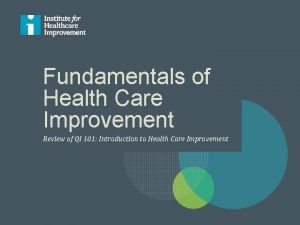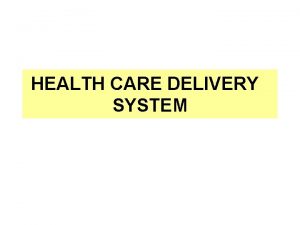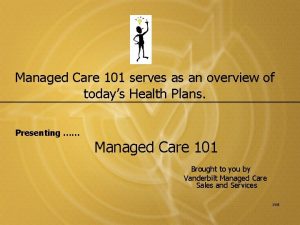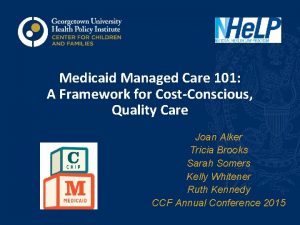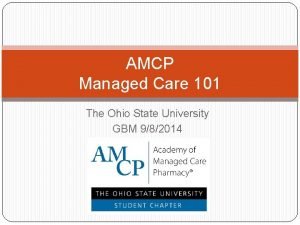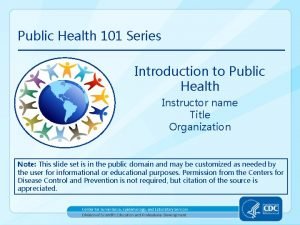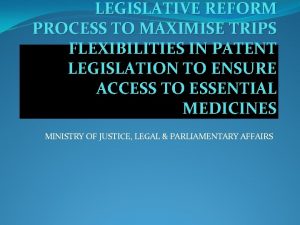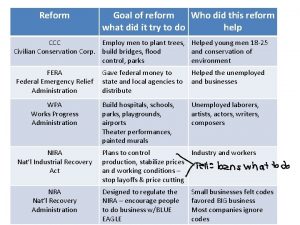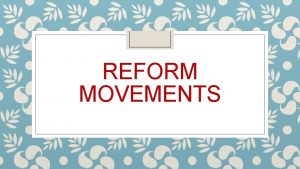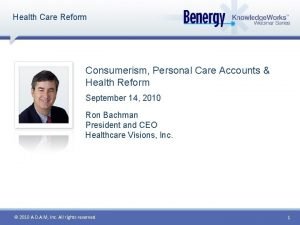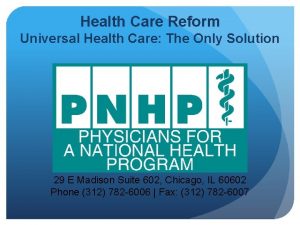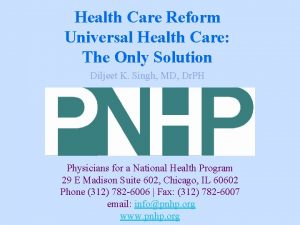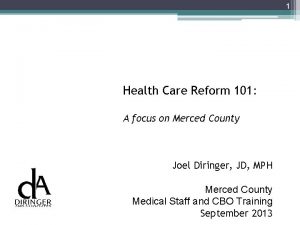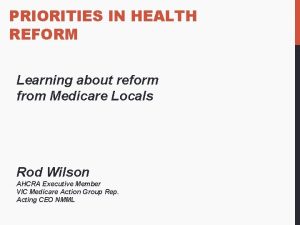Health Care Reform 101 Introduction To health Care






































- Slides: 38

Health Care Reform 101

Introduction To health Care Reform 101 Current Structure Of the US Health Care System 103 History of US Health Care 102 The Ethics and Philosophy of Healthcare Reform 104 Introduction To Issues of Quality 120 Introduction to Issues of Access 130 Medicare 135 Problems with The Cost Of Health care 210 Problems with The Quality Of Health Care 220 Problems with Access to Health Care 230 The frustration Within the Public community 235 The frustration Within the Medical community 240 The frustration Within the Business Community 245 Sustainability 310 International Comparisons Of Quality 320 Urban Hospital Crisis 330 Public Program Failures 335 Malpractice Costs 340 Negotiation w/ Private Insurance 345 For Profit Private Ins 311 Failures in Public Health 321 The Problem of Underinsurance 331 Pharmaceuticals 312 Unnecessary Medical Care 313 Health care for the Undocumented 332 Medicare In Detail 336 Medicaid 140 Employer Based Insurance 145 Methods of Reimbursement Introduction to Issues of Cost 110 Intro to Managed Care 147 Capitation 148 146 Introduction to The Solutions For US Health Care 105 Methods of Healthcare Organization 106 Models for Health Care Reform 150 Reform Proposals: Terminology Defined 152 Introduction to Advocacy for Health Care Reform 107 Comparison of National Health Plans 170 Intro Single Payer 250 Mixed Public/Private Models 260 Private Health Savings Account Model (CDHC) 265 Other Solutions To the Crisis 266 Single Payer Pros 351 Mixed Reform Pros 361 CDHC Pros 366 Malpractice Reform 366 Hassle Factors 341 Single Payer Cons 352 Mixed Reform Cons 362 CDHC Cons 367 Reimbursement 342 How much is government Involved; Roemer’s Model 151 Obama 2008 363 The direct medical Care model 368 Massachusetts 364 Thinking about How to get Involved 108 Personal Advocacy in Health Care Reform 190 Intro To Legislative Process and advocacy 180 Legislative Advocacy 280 Intro to Community Advocacy 285 Health Reform Organizations 290 Canada 270 Script Building 381 Mobilizing Groups 385 AMSA 390 The technology Solution 367 UK 271 Relationship building 382 Community Reform 386 PNHP 391 The Primary Care Solution 368 France 272 Japan 273 For Profit Hospitals 314 Denmark 274 Technology Cost 315 Netherlands 275

Introduction To health Care Reform 101 Current Structure Of the US Health Care System 103 History of US Health Care 102 The Ethics and Philosophy of Healthcare Reform 104 Introduction To Issues of Quality 120 Introduction to Issues of Access 130 Medicare 135 Problems with The Cost Of Health care 210 Problems with The Quality Of Health Care 220 Problems with Access to Health Care 230 The frustration Within the Public community 235 The frustration Within the Medical community 240 The frustration Within the Business Community 245 Sustainability 310 International Comparisons Of Quality 320 Urban Hospital Crisis 330 Public Program Failures 335 Malpractice Costs 340 Negotiation w/ Private Insurance 345 For Profit Private Ins 311 Failures in Public Health 321 The Problem of Underinsurance 331 Pharmaceuticals 312 Unnecessary Medical Care 313 Health care for the Undocumented 332 Medicare In Detail 336 Medicaid 140 Employer Based Insurance 145 Methods of Reimbursement Introduction to Issues of Cost 110 Intro to Managed Care 147 Capitation 148 146 Introduction to The Solutions For US Health Care 105 Methods of Healthcare Organization 106 Models for Health Care Reform 150 Reform Proposals: Terminology Defined 152 Introduction to Advocacy for Health Care Reform 107 Comparison of National Health Plans 170 Intro Single Payer 250 Mixed Public/Private Models 260 Private Health Savings Account Model (CDHC) 265 Other Solutions To the Crisis 266 Single Payer Pros 351 Mixed Reform Pros 361 CDHC Pros 366 Malpractice Reform 366 Hassle Factors 341 Single Payer Cons 352 Mixed Reform Cons 362 CDHC Cons 367 Reimbursement 342 How much is government Involved; Roemer’s Model 151 Obama 2008 363 The direct medical Care model 368 Massachusetts 364 Thinking about How to get Involved 108 Personal Advocacy in Health Care Reform 190 Intro To Legislative Process and advocacy 180 Legislative Advocacy 280 Intro to Community Advocacy 285 Health Reform Organizations 290 Canada 270 Script Building 381 Mobilizing Groups 385 AMSA 390 The technology Solution 367 UK 271 Relationship building 382 Community Reform 386 PNHP 391 The Primary Care Solution 368 France 272 Japan 273 For Profit Hospitals 314 Denmark 274 Technology Cost 315 Netherlands 275

101: Introduction to Healthcare Reform n n n Describe the basic components of the healthcare system List problems associated with American healthcare system in terms of three domains – cost, quality, access & disparities Compare the general concepts of a “solution” to the healthcare crisis including health savings accounts, reform of private insurance, mixed solutions and single payer RETURN TO MAIN

102: History of US Healthcare System n n n Review the history of health insurance in the United States Outline the social and economic forces that shaped our current system Broadly delineate what we get for our investment RETURN TO MAIN

103: Current Structure of the US Healthcare System 1. 2. 3. Outline the four basic modalities for paying for healthcare services Define and differentiate the terms “financing” and “reimbursement” in the context of components of healthcare payments Discuss managed care in the United States RETURN TO MAIN

104: The Ethics and Philosophy of Healthcare Reform n n Describe the basic ethical questions that are brought up by healthcare reform Apply ethical principles to discuss the following questions: q q q Is healthcare a privilege or a right? How and when to withhold futile care Value to society (cost-containment) versus value to the individual (high cost/futile care) RETURN TO MAIN

107: Introduction to Advocacy for Healthcare Reform n n n Chart the basic history of major health reform efforts in the past century Identify the major players advocating for healthcare reform and how they were formed and underline the basic perspective represented by each Recognize the need for health reform by healthcare professionals RETURN TO MAIN

105: Introduction to Solutions for US Healthcare n n n Summarize the major deficiencies of the current system as those that require solving problems of cost, quality and access Classify the major approaches to fixing access to healthcare as relying on a government-based solution or a private market-based solution Explain how advocates of the both the government-based and private market-based approaches claim that their solution also impacts cost and quality RETURN TO MAIN

120: Introduction to the Issues of Quality 1. 2. 3. Understand what is meant by ‘quality’ in the context of the healthcare system and identify some basic measures of healthcare quality Explain where the United States ranks general measures of healthcare quality Identify at least five factors that contribute to healthcare quality and the mechanism by which they do Return to Main

130: Introduction to the Issues of Access 1. 2. 3. Define the terms “uninsured” and “underinsured” Identify the number of Americans currently uninsured or underinsured Discuss whether it is a problem to be “uninsured” or “underinsured” in the United States Return to Main

135: Introduction to Medicare n n n Explain when Medicare was established and for what basic purpose Recognize the approximate number of Americans currently covered by Medicare and project out to 2031 List eligibility criteria for Medicare Explain what is covered by Medicare Part A and Part B Explain what is meant by the term “Traditional Medicare” RETURN TO MAIN

235: Frustration within the Public Community n n n Explain why the at least 1 in every 6 Americans have wait times of ‘infinity’ in obtaining healthcare services Explain how the current system restricts patients’ ability to visit the physician of their choice Explain how prescription drugs are unaffordable to many Americans, even with health insurance coverage and/or Medicare RETURN TO MAIN

240: Frustration within the Medical Community Explain why the current system: 1. Increases overhead costs for healthcare providers 2. Restricts appropriate medical decisionmaking due to health insurance company regulations 3. Rewards quantity over quality 4. Rewards costly specialty procedures over preventive medicine and primary care RETURN TO MAIN

245: Frustration within the Business Community § § Explain how the current system: Places the burden of purchasing healthcare on businesses large and small Can cause bankruptcy for smaller businesses with a very sick employee or family member Can lead to substantial overhead costs in large companies like GM RETURN TO MAIN

140: Introduction to Medicaid n n n Describe Medicaid in terms of its purpose, funding source and eligibility criteria Identify major differences between Medicare and Medicaid, with special attention to purpose, funding source, and eligibility criteria Recognize that Medicaid provides the largest portion of federal money spent on healthcare for people living with HIV RETURN TO MAIN

145: Employer-based Insurance n n Define what is meant by “employer-based” insurance and identify the percentage of private health coverage in the United States that is employer-based Identify the average employee contribution to employer-based coverage in 2008 RETURN TO MAIN

147: Managed Care n n n Define the term “managed care” and explain when it was created and for what purpose Explain the terms HMO, IPA, PPO and POS and rank them in order of most restrictive to least restrictive Assess the success of managed care in the United States in the areas of quality and cost control RETURN TO MAIN

110: Introduction to the Issues of Cost 1. 2. 3. 4. Recognize the magnitude of healthcare costs in the United States Define a “payer” of healthcare, and identify the major payers of healthcare in the US Grasp the magnitude of costs for common medical interactions such as a visit to a primary care physician for a general checkup, a mammogram, an appendectomy, or a total knee replacement Identify the at least five sources of expense that contribute to healthcare cost Return to Main

146: Methods of Reimbursement 1. 2. Be able to explain the terms fee-for-service, per-diem, diagnosis-related-groups and capitation in the context of healthcare payments Differentiate between methods of hospital reimbursement versus provider reimbursement RETURN TO MAIN

150: Models of Healthcare n n n Explain in broad terms the basis of a singlepayer system, a mixed public/private system and a ‘consumer driven’ healthcare system Rank a single payer system, a mixed public/private system and a ‘consumer driven healthcare’ system in order of increased government involvement Differentiate “socialized medicine” from “socialized health insurance” and understand the role of government in healthcare RETURN TO MAIN

151: Reform Proposals: Terminology Defined n n n Define the terms “moral hazard”, “socialism”, “capitalism”, “socialized medicine”, “socialized health insurance” Define the terms “subsidy”, “health savings account” and “flexible savings account” Define the terms “medical underwriting” and “cherry-picking” in the context of healthcare systems RETURN TO MAIN

250: Introduction to Single-Payer 1. 2. 3. Define and describe what is meant by a single-payer system Explain why single-payer is a form of socialized health insurance and not of socialized medicine Identify other countries that have a singlepayer system in place RETURN TO MAIN

351: Single Payer Pros Explain why advocates of single-payer system claim it could: 1. provide universal health coverage 2. lower administrative costs 3. avoid problems of moral hazard like competitive pressures that encourage medical underwriting and exclusions 4. avoid medical bankruptcies 5. encourage preventive medicine RETURN TO MAIN

352: Single Payer Cons Explain why critics of a single payer system argue that it could: 1. Increase the cost of medical care 2. Allow healthcare coverage to be at the whims of the national economy and federal budget 3. Decrease the earnings of physicians 4. Increase waiting times for medical procedures RETURN TO MAIN

260: AMA’s Mixed Public/Private Model 1. Define a mixed public/private model for 2. healthcare Describe the components of a mixed public/private model such as the one advocated by the AMA with particular attention to its use of tax credits for lowincome individuals, deregulation of the insurance industry government subsidies for high-risk patients RETURN TO MAIN

361: Mixed Public/Private Pros Explain why advocates of this approach claim that it will: 1. Reduce the number of uninsured 2. Curb healthcare costs 3. Improve quality RETURN TO MAIN

362: Mixed Public/Private Cons Explain why critics of this approach claim that it will: 1. Not resolve the crisis of the uninsured 2. Continue to incentivize “cherry-picking” and medical underwriting, thereby continuing to place an undue burden on the public system while making the private system even more profitable 3. Not fix the problem of increasing healthcare costs RETURN TO MAIN

265: Private Model Using Health Savings Accounts (Consumer Driven Health 1. Define. Care) the term “consumer driven health 2. care” in the context of a plan using the health savings account (HSA) as its primary modality to pay for healthcare Explain CDHC’s use of high-deductible health insurance policies to protect against catastrophic medical expenses RETURN TO MAIN

366: Consumer Driven Healthcare Pros Explain why proponents of CDHC argue that it will: 1. Lower the cost of health insurance premiums 2. Drive down the costs of healthcare systemwide and increase the quality of that healthcare by fostering market competition 3. Remove the burden of healthcare costs from employers 4. Increase individual responsibility. RETURN for medical TO MAIN

367: Consumer Driven Healthcare Cons Explain why critics of CDHC argue that it: n Will cause consumers to avoid obtaining needed and appropriate healthcare due to cost n Ignores the inability to the average patient to make ‘informed decisions’ about healthcare n Shifts the cost of healthcare back to the patient n Severely disadvantages patients with chronic illnesses RETURN TO MAIN

148: Capitation 1. 2. 3. Define the term ‘capitation’ Analyze the impact of a capitation-based payment method on cost, quality and access for health services Recognize the incentives created by a capitation payment scheme in terms of patient care and income generation for a given health care provider RETURN TO MAIN

170: Comparison of National Health Plans 1. 2. Define the terms primary care, secondary care, and tertiary care Differentiate the regionalized from dispersed models of healthcare organization in the context of cost, quality, and access to health services RETURN TO MAIN

230: Problems with Access to Healthcare 1. 2. 3. Differentiate between financial and nonfinancial barriers to healthcare access Stratify the uninsured population by demographics of age, income, employment status and race Reconcile major inter-demographic differences in the uninsured population through the lens of financial and nonfinancial barriers to access RETURN TO MAIN

136: Medicare In Detail n n n Identify coverage gaps in Medicare Part A and Part B, and list some ways to supplement these coverage gaps Explain what is meant by Medicare HMO, Medicare Advantage, Medigap and Medicare Supplemental Insurance and understand how these programs are administered (private vs. public) Describe Medicare Part D and explain how it is different than Parts A and B in terms of design, standardization and administration of RETURN TO MAIN its programs

Introduction To health Care Reform 101 History of US Health Care 102 Current Structure Of the US Health Care System 103 Is Health Care a Right or a Privilege? 104 Introduction to Issues of Cost 110 Introduction To Issues of Quality 120 Introduction to Issues of Access 130 Medicare 135 Medicaid 140 Employer Based Insurance 145 Problems with The Cost Of Health care 210 Problems with The Quality Of Health Care 220 Problems with Access to Health Care 230 The frustration Within the Public community 235 The frustration Within the Medical community 240 The frustration Within the Business Community 245 Sustainability 310 International Comparisons Of Quality 320 Urban Hospital Crisis 330 Public Program Failures 335 Malpractice Costs 340 Negotiation w/ Private Insurance 345 For Profit Private Ins 311 Failures in Public Health 321 The Problem of Underinsurance 331 Hassle Factors 341 Health care for the Undocumented 332 Reimbursement 342 Pharmaceuticals 312 Unnecessary Medical Care 313 Introduction to The Solutions For US Health Care 105 HMOs, PPOs, Capitation 147 Models for Health Care Reform 150 Introduction to Advocacy for Health Care Reform 106 How much is government Involved; Roemer’s Model 151 Reform Proposals: Terminology Defined 152 Intro Single Payer 250 Mixed Public/Private Models 260 Private Health Savings Account Model 265 Other Solutions To the Crisis 266 Single Payer Pros 351 Mixed Reform Pros 361 HSA Pros 366 Malpractice Reform 366 Single Payer Cons 352 Mixed Reform Cons 362 HAS Cons 367 Obama 2008 363 The direct medical Care model 368 Massachusetts 364 International Models of Health Care 170 Thinking about How to get Involved 107 Personal Advocacy in Health Care Reform 190 Intro To Legislative Process and advocacy 180 Legislative Advocacy 280 Intro to Community Advocacy 285 Health Reform Organizations 290 Canada 270 Script Building 381 Mobilizing Groups 385 AMSA 390 The technology Solution 367 UK 271 Relationship building 382 Community Reform 386 PNHP 391 The Primary Care Solution 368 France 272 Japan 273 For Profit Hospitals 314 Denmark 274 Technology Cost 315 Netherlands 275

n n I took a crack at organizing this curriculum. I tried to use all of your courses in about the same structure. I should not have any duplicates for the numbers. I have no 400 level courses in this curriculum. I suggest that 400 level course be personal stories and anecdotes that fit the course “above it” for example a personal account of losing insurance might go in the 430 courses.

 L101 introduction to healthcare leadership
L101 introduction to healthcare leadership Qi 101: introduction to health care improvement
Qi 101: introduction to health care improvement Health care 101
Health care 101 Continuum of care reform
Continuum of care reform Levels of care primary secondary tertiary quaternary
Levels of care primary secondary tertiary quaternary Introduction to healthcare delivery systems
Introduction to healthcare delivery systems Introduction to health care agencies
Introduction to health care agencies Unit 2 equality diversity and rights
Unit 2 equality diversity and rights Current state vs future state slide
Current state vs future state slide It 101 - introduction to computing
It 101 - introduction to computing Cs101 vu edu pk
Cs101 vu edu pk Cs101 vu edu pk
Cs101 vu edu pk Health and social care component 3
Health and social care component 3 Managed care 101
Managed care 101 Managed care 101
Managed care 101 Amcp osu
Amcp osu Public health 101
Public health 101 Paula stewart medical officer of health
Paula stewart medical officer of health The spirit of reform lesson 1
The spirit of reform lesson 1 Was the tva a relief recovery reform
Was the tva a relief recovery reform Chapter 8 section 1 religion sparks reform
Chapter 8 section 1 religion sparks reform When was the education reform movement
When was the education reform movement Reform movements 1800s
Reform movements 1800s 10.sınıf tarih reform hareketleri
10.sınıf tarih reform hareketleri Law reform process
Law reform process Land reform definition
Land reform definition Land reform def
Land reform def Late qing reform
Late qing reform Was the tva a relief recovery reform
Was the tva a relief recovery reform Urban settlement geography grade 12
Urban settlement geography grade 12 Define the word reform
Define the word reform Democratic reform and activism
Democratic reform and activism Chapter 10 section 1 democratic reform and activism
Chapter 10 section 1 democratic reform and activism Chapter 8 section 1 religion sparks reform
Chapter 8 section 1 religion sparks reform Chapter 23 lesson 3 nationalism unification and reform
Chapter 23 lesson 3 nationalism unification and reform Dorothea dix with my eyes i see
Dorothea dix with my eyes i see An era of reform chapter 18 answer key
An era of reform chapter 18 answer key The ferment of reform and culture
The ferment of reform and culture Republic act no. 55 manuel roxas
Republic act no. 55 manuel roxas

